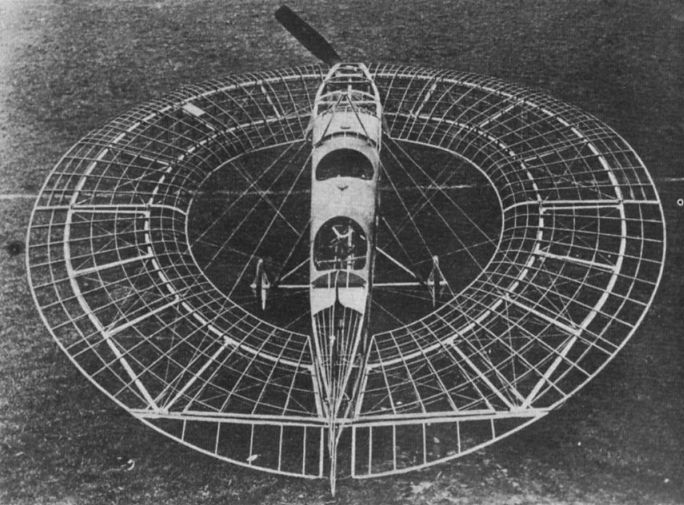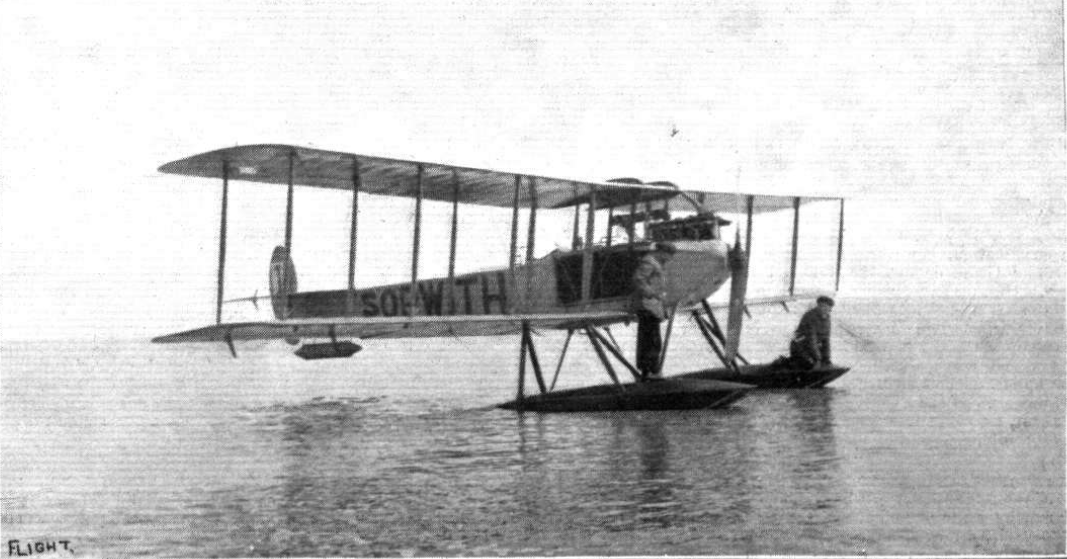|
Bristol Biplane Type T
The Bristol Biplane Type 'T', sometimes called the Challenger-Dickson Biplane, was a derivative of the Bristol Boxkite. It was built in 1911 by the British and Colonial Aeroplane Company and was designed as a cross-country racing aircraft for Maurice Tabuteau. Development The Type 'T' was not a development of the Bristol Boxkite but did use some of the experience gained with the Boxkite. It was designed by George Challenger, with the assistance of practical advice from Captain Bertram Dickson, a prominent pilot of the day. It had the same "Farman" configuration as the Boxkite, differing principally in having an enclosed nacelle to house the pilot. The structure bearing the front elevator also differed substantially: the elevator was mounted lower down, level with the lower wing, and the undercarriage skids were continued forward and upwards to form part of the elevator mounting. The rear-mounted twin rudders were balanced, unlike those of the Boxkite. The first aircraft (Bri ... [...More Info...] [...Related Items...] OR: [Wikipedia] [Google] [Baidu] |
Bristol Aeroplane Company
The Bristol Aeroplane Company, originally the British and Colonial Aeroplane Company, was both one of the first and one of the most important British aviation companies, designing and manufacturing both airframes and aircraft engines. Notable aircraft produced by the company include the 'Boxkite', the Bristol Fighter, the Bulldog, the Blenheim, the Beaufighter, and the Britannia, and much of the preliminary work which led to Concorde was carried out by the company. In 1956 its major operations were split into Bristol Aircraft and Bristol Aero Engines. In 1959, Bristol Aircraft merged with several major British aircraft companies to form the British Aircraft Corporation (BAC) and Bristol Aero Engines merged with Armstrong Siddeley to form Bristol Siddeley. BAC went on to become a founding component of the nationalised British Aerospace, now BAE Systems. Bristol Siddeley was purchased by Rolls-Royce in 1966, who continued to develop and market Bristol-designed engines. ... [...More Info...] [...Related Items...] OR: [Wikipedia] [Google] [Baidu] |
Graham Gilmour
Graham Gilmour (5 March 1885 – 17 February 1912) was a British pioneer aviator, known for his impromptu public displays of flying. He was killed on 17 February 1912 when his Martin-Handasyde monoplane suffered a structural failure and crashed in the Old Deer Park in Richmond, London. Early life Gilmore was born at Blackheath in Kent on 5 March 1885, the son of David Gilmour of Shanghai and Margaret Jane (née Muirhead), and educated at Clifton College as an Engineer. He started his practical engineering training at Allens of Bedford from 1905 to 1907 and then to the Adams Motor Company where he specialised in internal combustion engines. Aviation career Gilmour went to the Rheims aviation meeting in August 1909 and bought himself a Blériot aircraft; he next had to learn to fly it. Gilmour learnt to fly in France, first at the Antoinette school at Pau school and later at the Blériot school, and was awarded French flying license No.75 on 19 May 1910. His Blériot did n ... [...More Info...] [...Related Items...] OR: [Wikipedia] [Google] [Baidu] |
Bristol Aeroplane Company Aircraft
Bristol () is a City status in the United Kingdom, cathedral city, unitary authority area and ceremonial county in South West England, the most populous city in the region. Built around the River Avon, Bristol, River Avon, it is bordered by the ceremonial counties of Gloucestershire to the north and Somerset to the south. The county is in the West of England combined authority area, which includes the Greater Bristol area (List of urban areas in the United Kingdom, eleventh most populous urban area in the United Kingdom) and nearby places such as Bath, Somerset, Bath. Bristol is the second largest city in Southern England, after the capital London. Iron Age hillforts and Roman villas were built near the confluence of the rivers River Frome, Bristol, Frome and Avon. Bristol received a royal charter in 1155 and was historic counties of England, historically divided between Gloucestershire and Somerset until 1373 when it became a county corporate. From the 13th to the 18th centur ... [...More Info...] [...Related Items...] OR: [Wikipedia] [Google] [Baidu] |
1910s British Civil Aircraft
Year 191 ( CXCI) was a common year starting on Friday of the Julian calendar. At the time, it was known as the Year of the Consulship of Apronianus and Bradua (or, less frequently, year 944 ''Ab urbe condita''). The denomination 191 for this year has been used since the early medieval period, when the Anno Domini calendar era became the prevalent method in Europe for naming years. Events By place Parthia * King Vologases IV of Parthia dies after a 44-year reign, and is succeeded by his son Vologases V. China * A coalition of Chinese warlords from the east of Hangu Pass launches a punitive campaign against the warlord Dong Zhuo, who seized control of the central government in 189, and held the figurehead Emperor Xian hostage. After suffering some defeats against the coalition forces, Dong Zhuo forcefully relocates the imperial capital from Luoyang to Chang'an. Before leaving, Dong Zhuo orders his troops to loot the tombs of the Han emperors, and then destroy Luoyang b ... [...More Info...] [...Related Items...] OR: [Wikipedia] [Google] [Baidu] |
Biplanes
A biplane is a fixed-wing aircraft with two main wings stacked one above the other. The first powered, controlled aeroplane to fly, the Wright Flyer, used a biplane wing arrangement, as did many aircraft in the early years of aviation. While a biplane wing structure has a structural advantage over a monoplane, it produces more drag (aerodynamics), drag than a monoplane wing. Improved structural techniques, better materials and higher speeds made the biplane configuration obsolete for most purposes by the late 1930s. Biplanes offer several advantages over conventional cantilever monoplane designs: they permit lighter wing structures, low wing loading and smaller span for a given wing area. However, interference between the airflow over each wing increases drag substantially, and biplanes generally need extensive bracing, which causes additional drag. Biplanes are distinguished from tandem wing arrangements, where the wings are placed forward and aft, instead of above and below. ... [...More Info...] [...Related Items...] OR: [Wikipedia] [Google] [Baidu] |
Tractor Configuration
In aviation, a tractor configuration is a propeller-driven fixed-wing aircraft with its engine mounted with the propeller in front, so that the aircraft is "pulled" through the air. This is the usual configuration; the pusher configuration places the airscrew behind, and "pushes" the aircraft forward. Through common usage, the word "propeller" has come to mean any airscrew, whether it pulls or pushes the aircraft. In the early years of powered aviation both tractor and pusher designs were common. However, by the midpoint of the First World War, interest in pushers declined and the tractor configuration dominated. Today, propeller-driven aircraft are assumed to be tractors unless stated otherwise. Origins The first successful airplanes to have a "tractor" configuration were the 1907 Santos-Dumont Demoiselle and Blériot VII. The first biplane airplane to have a "tractor" configuration was the Goupy No.2 (first flight on 11 March 1909) designed by Mario Calderara and f ... [...More Info...] [...Related Items...] OR: [Wikipedia] [Google] [Baidu] |
Howard Pixton
Cecil Howard Pixton (14 December 1885 – 7 February 1972) was a British aeronautical engineer, test pilot and air racing pilot who was most famous for winning the 1914 Schneider Trophy seaplane race. Early life Howard Pixton was the youngest of four boys born to John Pixton, a stockbroker, and his wife Elizabeth, living in West Didsbury, Manchester. They holidayed annually in the Isle of Man, and Howard was educated at Manchester Grammar School. He then worked at engineering companies, becoming a machine tool draughtsman, studying engineering in the evenings. He moved to Leek, Staffordshire to work for an engineering company to gain practical experience. Moving on to work for a local garage, he was asked to drive some customers to Germany, calling in at an aeronautical exhibition in Frankfurt on the way. Pixton thus saw his first aeroplane, and several airships, and having always been fascinated by the current advances in aviation he became determined to learn to fly. In Apri ... [...More Info...] [...Related Items...] OR: [Wikipedia] [Google] [Baidu] |
Eric Gordon England
Eric Cecil Gordon England (5 April 1891 – February 1976) FRAeS, AFRAeS, FIMT,Gordon England Ltd. ''The Times'', Tuesday, 5 February 1929; p. 18; Issue 45119. was a British aviator, racing driver and engineer.Who Was Who, A & C Black, 1920–2008; online edn, Oxford University Press, Dec 2007 http://www.ukwhoswho.com/view/article/oupww/whowaswho/U154245 accessed 24 November 2010 E.C. Gordon England was one of the early pioneers of gliding, and his Glider (sailplane), glider flight in 1909 is considered to be the birth of the sport of Gliding, soaring. Early years Gordon England was born in Argentina in 1891, the son of British parents George and Amy England. He emigrated to England at age ten, and he was first educated at New College, Eastbourne; then from 1904 to 1906 at Framlingham College in Suffolk. He then started an engineering apprenticeship with the Great Northern Railway (Great Britain), Great Northern Railway works at Doncaster becoming a fellow-apprentice of W O Bentl ... [...More Info...] [...Related Items...] OR: [Wikipedia] [Google] [Baidu] |
Daily Mail Circuit Of Britain Air Race
The ''Daily Mail'' Circuit of Britain air race was a British cross-country air race that took place from 1911 until 1914, with prizes donated by the ''Daily Mail'' newspaper on the initiative of its proprietor, Alfred Harmsworth, 1st Viscount Northcliffe, Lord Northcliffe. It was one of Daily Mail aviation prizes, several races and awards offered by the paper between 1906 and 1925. The 1911 race took place on 22 July and was a event with 11 compulsory stops and a circular route starting and finishing at Brooklands in Surrey. The winner was Jean Louis Conneau, Jean Conneau in a Blériot XI who took 22 hours, 28 minutes to complete the course, an average speed of and received the first prize of £10,000. The runner up was Jules Védrines in a Morane-Borel monoplane with James Valentine (aviator), James Valentine, in a Deperdussin 1910 monoplane, Deperdussin, third. The 1913 race was for British seaplanes and had a first prize of £5,000. Only one aircraft started the course; ... [...More Info...] [...Related Items...] OR: [Wikipedia] [Google] [Baidu] |
George Henry Challenger
George Henry Challenger (1881–1947) was a British aviator and aero-engineer, originally with the Bristol Aeroplane Company and later with Vickers. He designed a number of aircraft and held a number of aviation-related patents. Early life Challenger was born on 3 June 1881 at Neath in Glamorganshire, Wales. He was originally employed as an engineer at the Bristol Tramways and Carriage Company where his father was chief engineer. Bristol With the formation of the British and Colonial Aeroplane Company in 1910 which started with leased premises from the Bristol Tramways and Carriage Company, Challenger moved across to the new aeroplane company as works manager and engineer. With the creation in 1911 of an experimental department, Challenger was sent to Larkhill to learn to fly and on 14 February 1911 he obtained his Royal Aero Club Aviators Certificate (No. 58). Among his designs at Bristol were the Bristol Boxkite and Bristol Glider. He left Bristol to work for the aviation de ... [...More Info...] [...Related Items...] OR: [Wikipedia] [Google] [Baidu] |





